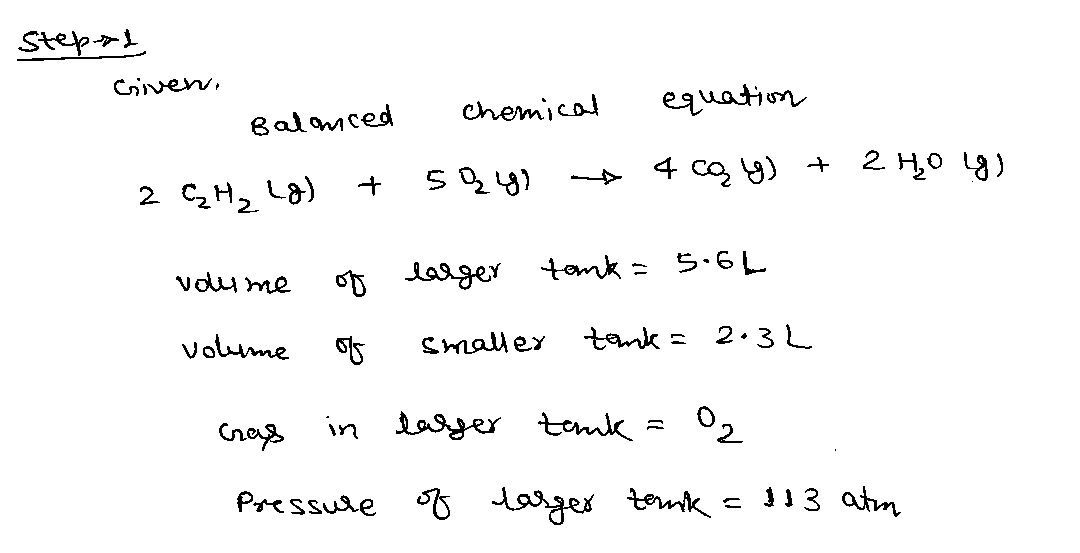Acetylene torches are used for welding. These torches use a mixture of acetylene gas, C2H2, and oxygen gas, O2 to produce the following combustion reaction: 2 C2H2 (g) + 5 O2 (g) →4 CO2 (g) + 2 H20 (g) Imagine that you have a 5.6 L gas tank and a 2.3 L gas tank. You need to fill one tank with oxygen and the other with acetylene to use in conjunction with your welding torch. If you fill the larger tank with oxygen to a pressure of 113 atm, to what pressure should you fill the acetylene tank to ensure that you run out of each gas at the same time? Assume ideal behavior for all gases. Express your answer numerically, in terms of atm to 0 decimal places.
Acetylene torches are used for welding. These torches use a mixture of acetylene gas, C2H2, and oxygen gas, O2 to produce the following combustion reaction: 2 C2H2 (g) + 5 O2 (g) →4 CO2 (g) + 2 H20 (g) Imagine that you have a 5.6 L gas tank and a 2.3 L gas tank. You need to fill one tank with oxygen and the other with acetylene to use in conjunction with your welding torch. If you fill the larger tank with oxygen to a pressure of 113 atm, to what pressure should you fill the acetylene tank to ensure that you run out of each gas at the same time? Assume ideal behavior for all gases. Express your answer numerically, in terms of atm to 0 decimal places.
Chemistry
10th Edition
ISBN:9781305957404
Author:Steven S. Zumdahl, Susan A. Zumdahl, Donald J. DeCoste
Publisher:Steven S. Zumdahl, Susan A. Zumdahl, Donald J. DeCoste
Chapter1: Chemical Foundations
Section: Chapter Questions
Problem 1RQ: Define and explain the differences between the following terms. a. law and theory b. theory and...
Related questions
Question

Transcribed Image Text:Acetylene torches are used for welding. These torches use a mixture of acetylene gas, C2H2, and
oxygen gas, O2 to produce the following combustion reaction:
2 C2H2 (g) + 5 O2 (g) → 4 CO2 (g) + 2 H20 (g)
Imagine that you have a 5.6 L gas tank and a 2.3 L gas tank. You need to fill one tank with oxygen
and the other with acetylene to use in conjunction with your welding torch. If you fill the larger tank
with oxygen to a pressure of 113 atm , to what pressure should you fill the acetylene tank to ensure
that you run out of each gas at the same time? Assume ideal behavior for all gases.
Express your answer numerically, in terms of atm to 0 decimal places.
Expert Solution
Step 1

Trending now
This is a popular solution!
Step by step
Solved in 3 steps with 3 images

Knowledge Booster
Learn more about
Need a deep-dive on the concept behind this application? Look no further. Learn more about this topic, chemistry and related others by exploring similar questions and additional content below.Recommended textbooks for you

Chemistry
Chemistry
ISBN:
9781305957404
Author:
Steven S. Zumdahl, Susan A. Zumdahl, Donald J. DeCoste
Publisher:
Cengage Learning

Chemistry
Chemistry
ISBN:
9781259911156
Author:
Raymond Chang Dr., Jason Overby Professor
Publisher:
McGraw-Hill Education

Principles of Instrumental Analysis
Chemistry
ISBN:
9781305577213
Author:
Douglas A. Skoog, F. James Holler, Stanley R. Crouch
Publisher:
Cengage Learning

Chemistry
Chemistry
ISBN:
9781305957404
Author:
Steven S. Zumdahl, Susan A. Zumdahl, Donald J. DeCoste
Publisher:
Cengage Learning

Chemistry
Chemistry
ISBN:
9781259911156
Author:
Raymond Chang Dr., Jason Overby Professor
Publisher:
McGraw-Hill Education

Principles of Instrumental Analysis
Chemistry
ISBN:
9781305577213
Author:
Douglas A. Skoog, F. James Holler, Stanley R. Crouch
Publisher:
Cengage Learning

Organic Chemistry
Chemistry
ISBN:
9780078021558
Author:
Janice Gorzynski Smith Dr.
Publisher:
McGraw-Hill Education

Chemistry: Principles and Reactions
Chemistry
ISBN:
9781305079373
Author:
William L. Masterton, Cecile N. Hurley
Publisher:
Cengage Learning

Elementary Principles of Chemical Processes, Bind…
Chemistry
ISBN:
9781118431221
Author:
Richard M. Felder, Ronald W. Rousseau, Lisa G. Bullard
Publisher:
WILEY